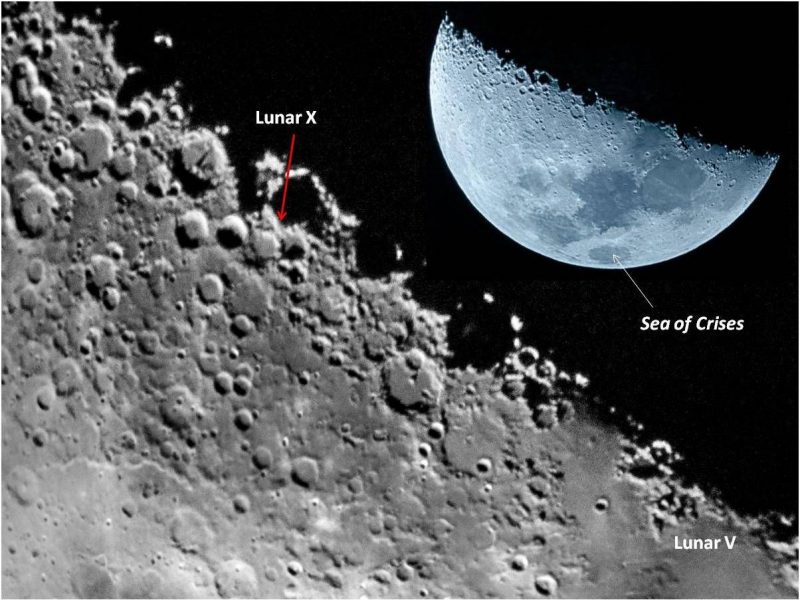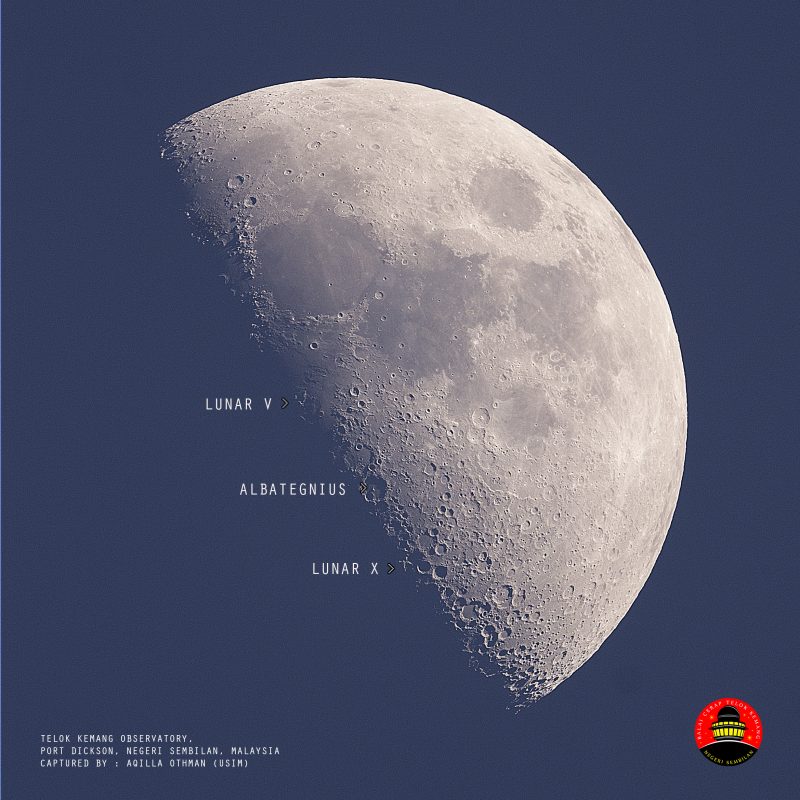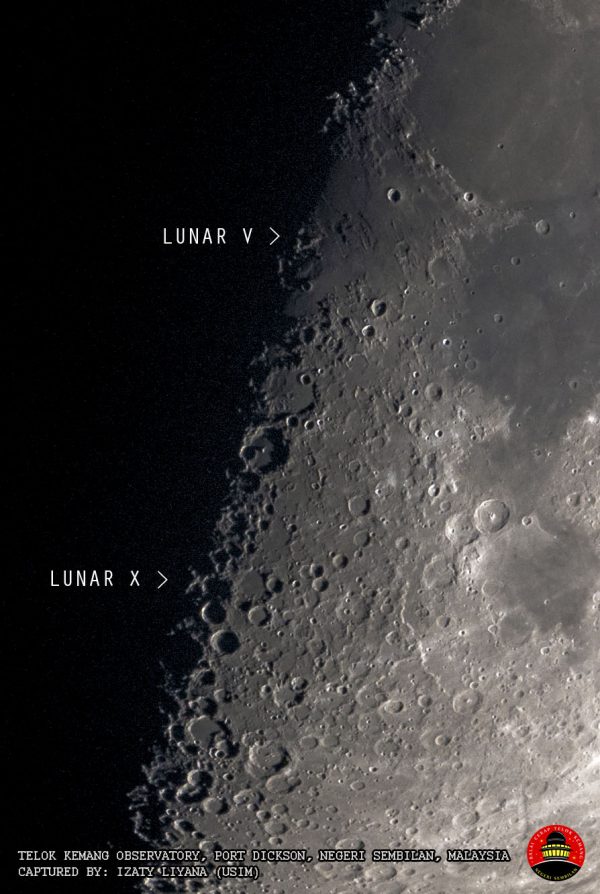

View at EarthSky Community Photos. | Composite image of a moon nearly at 1st quarter with some of the features you can see on the moon at this phase – captured April 30, 2020 – by our friend Dr Ski in the Philippines. He wrote: “… 10 hours before 1st quarter and the Lunar V and Lunar X are well defined …” More about Lunar V and X below. Thank you, Dr Ski!
Here are the characteristics of a first quarter moon:
– It’s the moon phase halfway between new moon and full moon.
– It’s a waxing moon.
– As viewed from anywhere on Earth, a first quarter moon appears at its highest in the sky at sunset. It sets around the middle of the night.
– It’s called a quarter moon, but, from Earth, it looks half-illuminated, like half a pie. Or you might say that – at first quarter moon – we’re seeing half the moon’s day side or a quarter of the whole moon.

Click here to see animation. As seen from the north side of the moon’s orbital plane, the Earth rotates counterclockwise on its rotational axis, and the moon revolves counterclockwise around Earth. The terminators of the Earth and moon align at first and last quarter moons, and only the near half of the moon’s day side is visible from Earth.
There’s another reason we call this moon a quarter and not a half. It’s because it’s one quarter of the way around in its orbit of Earth, as measured from one new moon to the next.
And what about the term half moon? That’s a beloved term, but not an official one.

Lunar X and Lunar V appear when the moon is near its 1st quarter phase. They aren’t really Xs and Vs on the moon. They’re just high areas, catching sunlight, creating an example of pareidolia on the moon. Aqilla Othman in Port Dickson, Negeri Sembilan, Malaysia, caught them both in May 2017. Notice that he caught Lunar X and Lunar V.

Here’s a closer look at Lunar X and Lunar V. Photo by Izaty Liyana in Port Dickson, Negeri Sembilan, Malaysia. What is Lunar X?

Tom Wildoner wrote: “One of my favorite areas to photograph on the moon near the 1st quarter! I captured this view of the sun lighting up the mountain range called Montes Apenninus. The moon was casting a nice shadow on the back side of the mountains. This mountain range is about 370 miles (600 km) long with some of the peaks rising as high as 3.1 miles (5 km).”
Bottom line: The next 1st quarter moon will come on Thursday, September 24, 2020, at 01:54 UTC. That is Wednesday, September 23, for U.S. time zones.
Read more: Top 4 keys to understanding moon phases
Check out EarthSky’s guide to the bright planets.
from EarthSky https://ift.tt/2OIzLvs


View at EarthSky Community Photos. | Composite image of a moon nearly at 1st quarter with some of the features you can see on the moon at this phase – captured April 30, 2020 – by our friend Dr Ski in the Philippines. He wrote: “… 10 hours before 1st quarter and the Lunar V and Lunar X are well defined …” More about Lunar V and X below. Thank you, Dr Ski!
Here are the characteristics of a first quarter moon:
– It’s the moon phase halfway between new moon and full moon.
– It’s a waxing moon.
– As viewed from anywhere on Earth, a first quarter moon appears at its highest in the sky at sunset. It sets around the middle of the night.
– It’s called a quarter moon, but, from Earth, it looks half-illuminated, like half a pie. Or you might say that – at first quarter moon – we’re seeing half the moon’s day side or a quarter of the whole moon.

Click here to see animation. As seen from the north side of the moon’s orbital plane, the Earth rotates counterclockwise on its rotational axis, and the moon revolves counterclockwise around Earth. The terminators of the Earth and moon align at first and last quarter moons, and only the near half of the moon’s day side is visible from Earth.
There’s another reason we call this moon a quarter and not a half. It’s because it’s one quarter of the way around in its orbit of Earth, as measured from one new moon to the next.
And what about the term half moon? That’s a beloved term, but not an official one.

Lunar X and Lunar V appear when the moon is near its 1st quarter phase. They aren’t really Xs and Vs on the moon. They’re just high areas, catching sunlight, creating an example of pareidolia on the moon. Aqilla Othman in Port Dickson, Negeri Sembilan, Malaysia, caught them both in May 2017. Notice that he caught Lunar X and Lunar V.

Here’s a closer look at Lunar X and Lunar V. Photo by Izaty Liyana in Port Dickson, Negeri Sembilan, Malaysia. What is Lunar X?

Tom Wildoner wrote: “One of my favorite areas to photograph on the moon near the 1st quarter! I captured this view of the sun lighting up the mountain range called Montes Apenninus. The moon was casting a nice shadow on the back side of the mountains. This mountain range is about 370 miles (600 km) long with some of the peaks rising as high as 3.1 miles (5 km).”
Bottom line: The next 1st quarter moon will come on Thursday, September 24, 2020, at 01:54 UTC. That is Wednesday, September 23, for U.S. time zones.
Read more: Top 4 keys to understanding moon phases
Check out EarthSky’s guide to the bright planets.
from EarthSky https://ift.tt/2OIzLvs

Aucun commentaire:
Enregistrer un commentaire